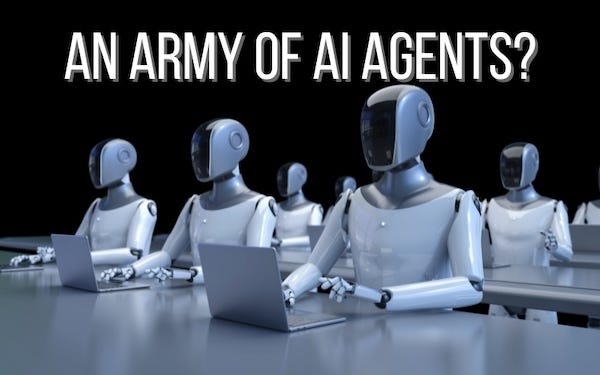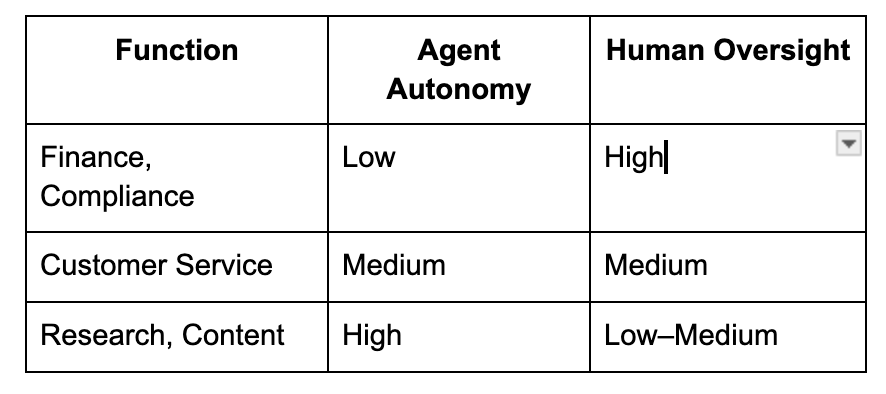Last week, I spoke with a founder who was excitedly walking me through their latest initiative: they were deploying “an army of AI agents” across their startup.
It was clear they’d put time and thought into the vision - automated customer service, AI-driven research assistants, marketing agents that could A/B test ad copy on the fly. I was impressed.
But then I asked a simple question:
“How many humans will be overseeing them?”
There was a pause. The kind of pause that says, we haven’t really thought that through.
This conversation has been stuck in my mind ever since, because it reflects a broader pattern I’m seeing almost everywhere right now.
Everyone’s racing to deploy AI agents.
Very few are thinking about the humans who need to manage them.
The Hype: AI Agents as the New Workforce
The rise of AI agents is arguably the biggest shift in SaaS and business operations we’ve seen in years.
Instead of relying solely on centralized AI tools or basic chatbots, we now can assign intelligent agents to handle discrete tasks: researching competitors, handling support tickets, rewriting product descriptions, and even scheduling meetings autonomously.
Tools like AutoGPT, LangChain, and emerging platforms like Cognosys and Hyper are making it easier than ever to deploy autonomous or semi-autonomous agents with memory, goals, and workflows.
The problem? They’re being shipped faster than we know how to manage them.
AI Isn’t Plug-and-Play
Despite all the hype, AI agents are not magic. They're still brittle, unpredictable, and require real human supervision, especially in high-stakes or customer-facing areas.
And yet, many founders are treating AI agents like interchangeable, infinitely scalable workers.
But unlike human teams, you can’t just “hire” a hundred agents and expect them to self-manage.
That brings us to a critical oversight:
The human-to-agent ratio.
Why the Human-to-Agent Ratio Matters
In most organizations deploying AI agents, I’m seeing one of two failure patterns:
Too few humans, too many agents.
Agents are sent out to execute without supervision or evaluation. Mistakes compound. The team loses visibility into what’s working. Metrics go dark. Trust erodes.Too many humans, not enough effective use.
The agents are underutilized. Humans end up babysitting tools that should be augmenting them, not draining their time.
The goal isn’t simply to “use more AI.”
It’s to use AI well, with the right level of human oversight and measurement.
That requires pausing to ask better questions:
What, exactly, are our agents doing?
How do we evaluate their performance?
Where do we need humans in the loop, and where can we afford to experiment?
The “Goldilocks Zone” of AI-Augmented Teams
There is no one-size-fits-all ratio. But there is a principle worth following: balanced augmentation.
Here’s what that looks like:
For mission-critical areas like finance or anything involving legal risk, AI agents should be closely supervised or used strictly as assistants, not decision-makers.
But in areas like content creation, knowledge management, and marketing iteration, you can safely give agents more autonomy, then evaluate performance based on outcomes.
You Can’t Optimize What You Don’t Measure
One of the most dangerous things I see in AI rollouts is a lack of metrics. If you don’t have a clear way to evaluate your agents’ performance—cost savings, time saved, improved output quality—you’re flying blind.
Founders should treat AI agents the same way they’d treat new team members:
Onboard them with clear expectations.
Monitor their performance with real data.
Iterate based on results, not assumptions.
Final Thought: AI Is a Multiplier, Not a Replacement
The founders who will win in this new wave of AI won’t be the ones who “automate the most.”
They’ll be the ones who integrate AI most intelligently.
That means:
Choosing use cases wisely.
Putting humans in the loop where it matters.
Measuring the impact of every agent in your system.
It also means slowing down just long enough to design a strategy, not just deploy a tool.
If you’re a business leader trying to wrap your head around where to start with AI, you might find this helpful: AI Strategy in 30 Minutes: A Crash Course for Business Leaders is a high-impact PDF guide I created to help you prioritize use cases, assess readiness, and make smart build vs. buy decisions. It’s a fast read, but it could save you weeks of trial and error.
The path forward with AI is to move smarter, not faster.
And getting your human-to-agent ratio right might just be the smartest first step you can take.





